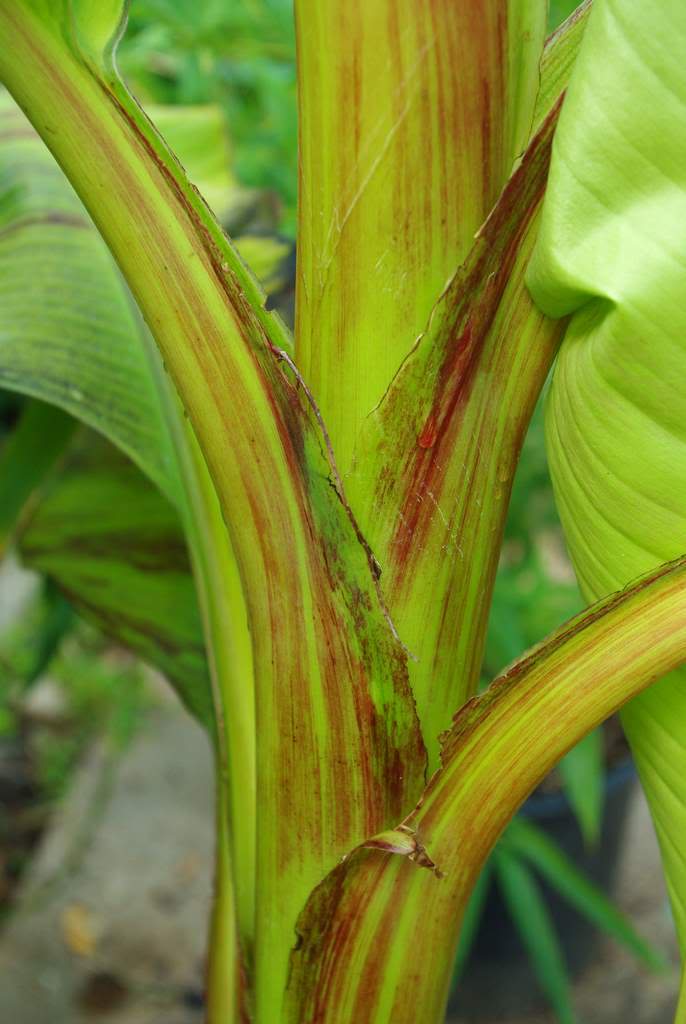At the end of June I got a few banana plants on sale. Let's take a look at how they're doing today, just under 2 months later. (It might help if you refer back to the original image.) First up is what was the smallest of the three plants, which is now the largest, depending on how you measure.
This plant is producing huge, beautiful leaves now. These leaves are over 3' long and about 1' wide.
I've never been a big fan of banana plants before, as I don't like the tattered look of the leaves after they've been damaged by wind.
These have not yet received much damage, but they have so much texture I don't know that I'd even care anymore if they did. Look at the subtle red edge on that leaf above! Nice!
I'm definitely a banana fan now. This plant itself is about 7' tall, although it's hard to measure because the new leaf will fall over once it unrolls:
A new leaf is produced about once a week, even though this plant is in a relatively small container:
It could probably use more room, and perhaps more fertilizer than I give it. I think next year it will go in the ground. I'll figure out where over the winter.
Moving on to the more colorful plant:
This one has always had a yellow cast to the leaves, and I'm not sure if that's normal for this plant or not. It's got a lot of red in it though doesn't it? This carries over into the stem too:
This plant isn't as large as the first one, but it's still a good size:
Once I figure out if the yellow is a nutrition or soil acidity problem the plant may do even better -- not that it's doing poorly now. It's producing "pups":
The "pups" are new shoots that I'll be able to remove and pot up, creating new plants. (Not like I need more plants. I can give them away though, or trade with some of my gardener friends.) That one pup is pretty large -- I think I need to research how to remove it soon.
The last plant of the three isn't a true banana, but is in the banana family. You can see that it has a different form than the other two plants:
It's really attractive, with great red highlights:
As you can see, this one has some damage to the newest leaves:
This looks like caterpillar damage to me. I unrolled the leaf a bit to show the full extent of the damage:
With all of the holes it looks like there's a horde of caterpillars on this, right? Well, it's just a single critter, but he's munching the leaves while they're emerging and still rolled up, which results in these interesting but ugly patterns of holes. Here's the culprit:
As soon as I saw this guy, I thought "oops"!
Remember a couple days ago when I found a couple of caterpillars on one of my coleus, and I flicked them out into the garden? The first one went quite far, all the way into one of my bamboos, where it certainly can't do any damage, even if it likes eating bamboo leaves.
The second caterpillar didn't launch as far, and I saw it land in the Mexican petunia, which is right next to this banana plant. Since this caterpillar looks very much like the one I flicked into the vicinity, I'm pretty certain it's the same one. So these ugly holes in the leaves of this beautiful plant are my fault!
I'm not too bothered by it though, because if this plant were in perfect condition, we'd probably get a big hailstorm that would shred all of the leaves. My experience tells me that whenever things are looking their best in my garden, the weather turns ugly and makes me wish I had taken more photos of the plants before the storm hit. I'll take a couple of caterpillar holes over a shredded plant any day.
(Looking back over these photos before hitting the "publish" button, I can't believe I once thought these plants were unattractive!)















No comments:
Post a Comment